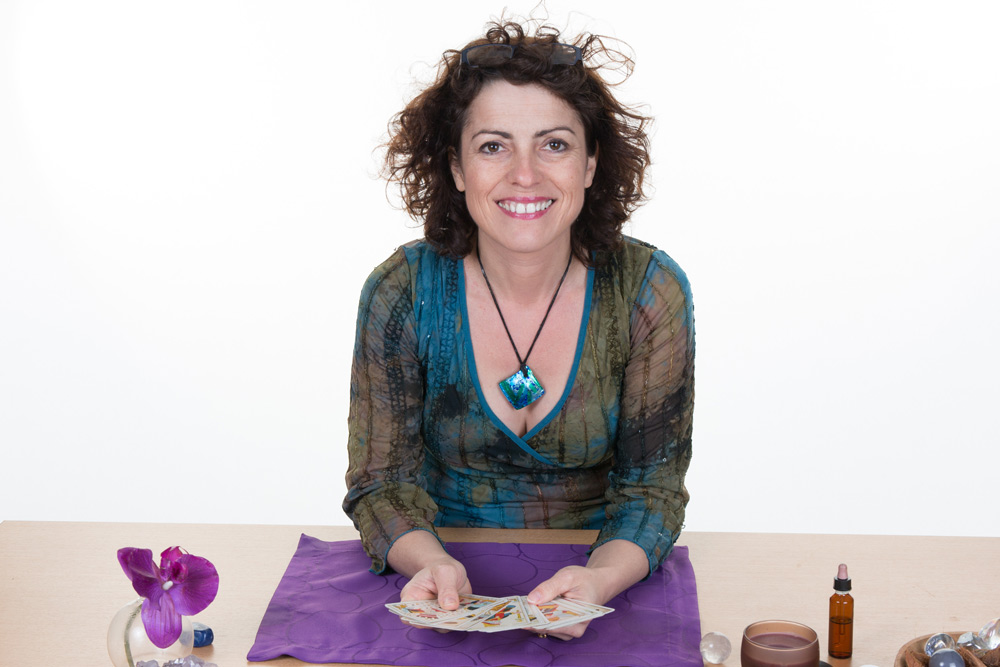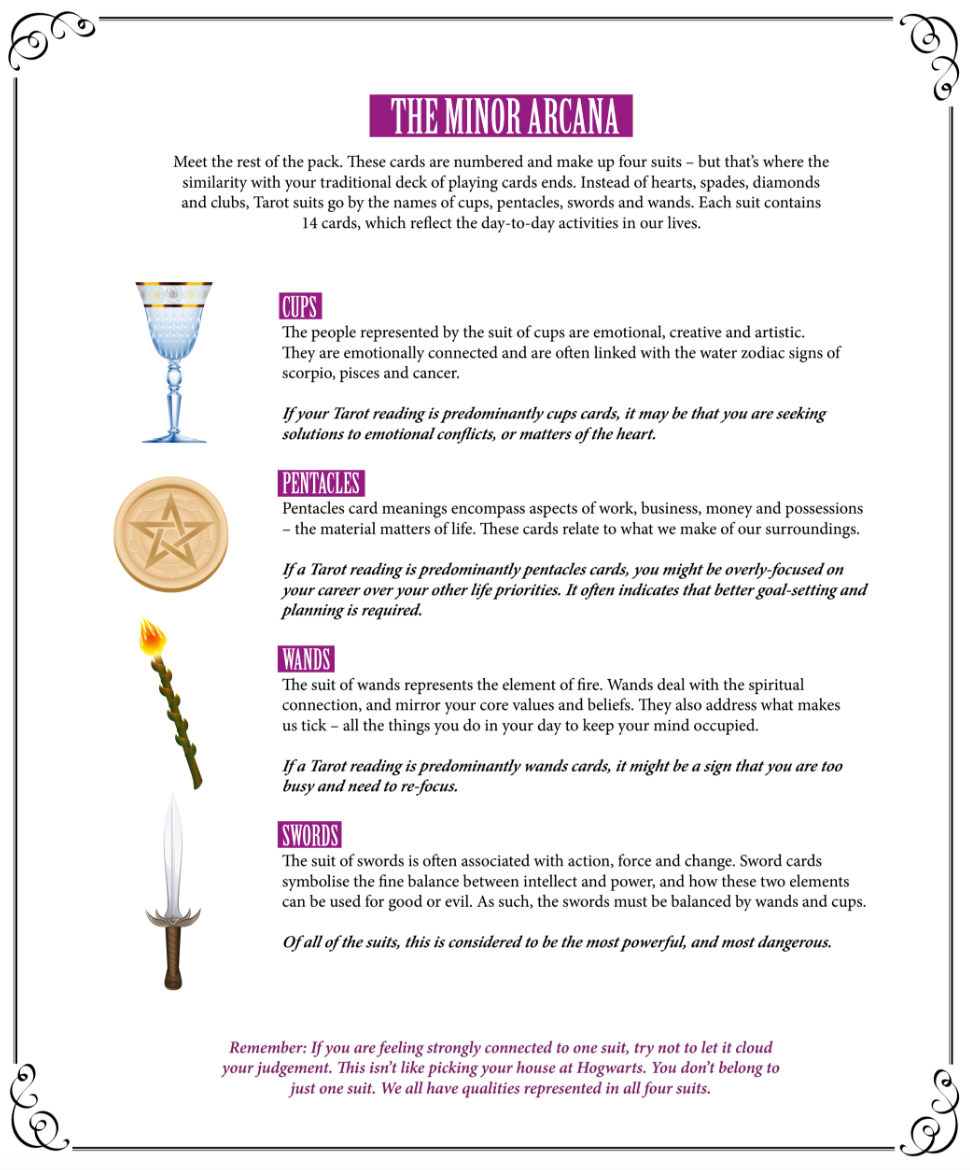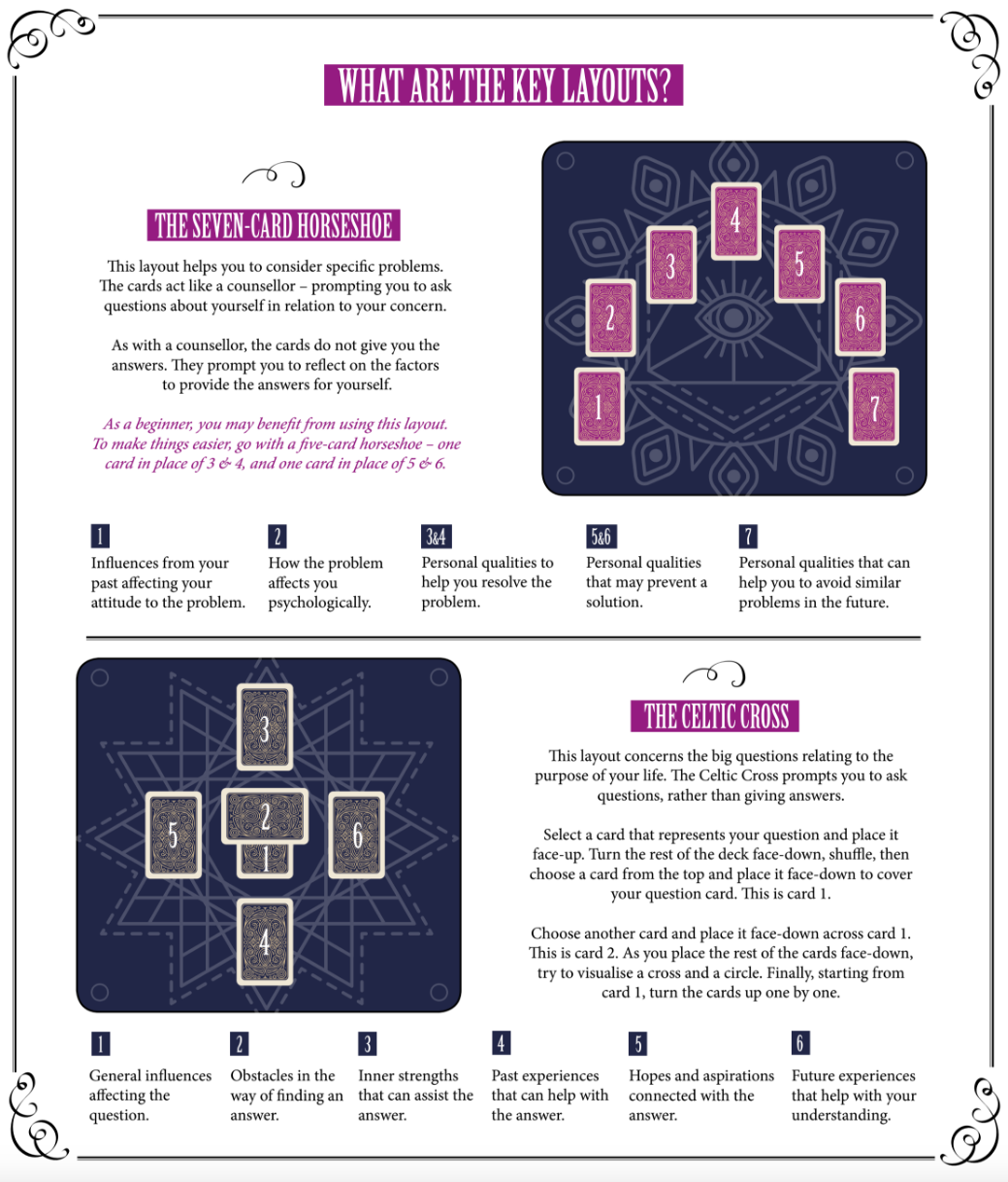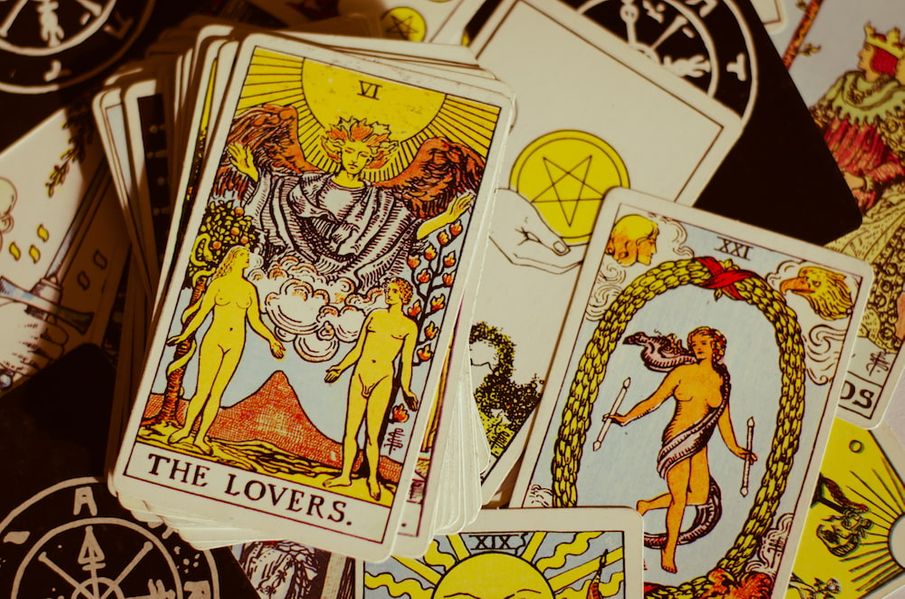Tarot, the ancient forerunner to today’s playing cards, is synonymous with fortune-telling, mysticism and wicked black magick
In reality, Tarot has more in common with analytical psychology than medieval mumbo-jumbo. Now, Tarot is enjoying a quiet revival – not as a spiritual guide, but as a motivational tool for self-development. happiful explains what Tarot is, how it works, and why it can help you to achieve your life goals.
All you need is an open mind...
The cards themselves aren't good or bad. They're only ink and paper. The 'magic' element is how you connect with them
The magician in his red robes. The fool on the hill. A skeleton on horseback. We’re not talking about the new season of Game of Thrones. We’re talking about the ancient tradition of Tarot cards.
For most people, this “wicked pack of cards” conjures up a twilight world of fortune-tellers laying down images on a black velvet table. Steeped in mystery, with its centuries-old iconography, sceptics might scoff at its relevance in our technological age. But Tarot is, in fact, enjoying a revival of sorts – and not in the spiritual sense.
Indeed, Tarot is becoming popular as a motivational tool to help people achieve their life goals – and to work out what their key stumbling blocks might be. Today, Tarot depends on the context given to it by the reader. The true magic of these reading cards is less about what they predict, and more about the power within yourself to tune-in to your emotions, your core beliefs, and your ability to take a wider view of your most complex dilemmas and desires.
What is Tarot?
Although Tarot has been knocking around for almost as long as other otherworldly practices, it doesn’t have an established usage in mainstream culture. We don’t even know for certain the original purpose of the cards.

Know thyself: Tarot can be as effective as any self-help book
Truth is, Tarot is something of a mystery. Some experts say they appeared in Europe “nearly overnight” at the beginning of the 1400s and were an instant best-seller. A best-guess scenario is that they were originally used for popular trick-taking games, rather like our modern game of bridge, and from there proceeded to be used in fortune-telling. But whatever its true origins, Tarot certainly captured the public’s imagination.
The intense symbolism of these image-driven cards contains echoes of ancient Egyptian deities such as Isis and Thoth, and there are hints, too, of Hebrew letters and Islamic art within the designs, which only served to heighten their mystery. But the true roots of Tarot are a lot closer to home – specifically Italy. Italian scholars were talking about “carte da giocare” (playing cards) as early as 1450.
Is Tarot evil?
Tarot cards were condemned by the Catholic church for their use in fortune-telling, and as a violation of the First Commandment (“I am the Lord thy God. Thou shalt have no other gods before me”), but this way of thinking is just as archaic as the history of Tarot.
The cards themselves aren’t intrinsically good or bad. They’re just cards. It’s only ink and paper. The “magical” element comes from how you connect a reading to your situation, and how you wish to make changes to your life. The magic is in us, not in the cards. Somewhat ironically, a photograph taken of Pope John Paul II in the Vatican in the early 1980s inadvertently revealed a pile of books on his desk – one was Meditations on Tarot.
That being said, it’s very easy to see the enchantment of Tarot’s imagery. You don’t have to be an art aficionado to appreciate the sheer beauty – and power – in these reading cards. Tarot communicates through visual symbolism in a way that transcends language barriers and cultural borders. Even the oldest decks in circulation have a timelessness to them, making them just as relevant to users now as they ever were hundreds of years ago.
Why is Tarot relevant today?
While earlier Tarot decks may have been influenced by folklore and superstition, newer Tarot decks have meanings linked to dream interpretation and the collective unconscious. Indeed, the symbolism of Tarot was duly recognised by the founders of psychology, Sigmund Freud and Carl Jung. Jung, in particular, was a keen practitioner of Tarot and wrote volumes on the cards’ central archetypes.
Psychologically speaking, the images on Tarot cards have been born out of a creative unconscious, and so represent truths about the inner workings of our mind. You might never have seen a Tarot card in your life, but you will already be very familiar with their meanings, even without realising it. Every Hollywood movie contains a hero, an antagonist, a mentor, a sidekick, a cynic, a love interest, and so on. All those characters are found in Tarot.
Tarot cards are able to speak to us through the archetypes they represent, which is where our friend Jung comes in. Jung popularised the theory of archetypes – the “partial personalities” found ingrained from birth in our subconscious minds. The archetypes in Tarot are likewise woven within myth and legend. We are brought up as children with an awareness of what these universal legends “represent”, from fairy tales and board games to our wildest childhood dreams.

Jung’s archetypes – the shadow, the ego, the anima – are constructed from our own life experiences. Each of us knows what they represent and how they may (or may not) relate to us as individuals. In fact, we know them so well that we’re pre-programmed to look for them in our everyday lives, because they help us to decode and understand the world.
These archetypes, or characters, form the basis of Tarot reading. The patterns that emerge from a reading can help you to understand the problems or difficulties in your life. Because tarot deals with symbolism (just as analytical psychology deals with symbolism) the reading of the “story” laid out in front of you can take your understanding of human behaviour right back to basics. The cards can also help to demonstrate the feelings that might be lurking just beneath the surface of your subconscious mind, and even bring you in touch with feelings you’ve subsumed, or refused to acknowledge.
Has Tarot influenced culture?
Yes, massively. The first three decades of the 20th century were a key moment in Western civilisation – two world wars, the birth of the car, the theory of relativity, and psychoanalysis. Creative geniuses like Picasso, Joyce and Duchamp were heavily indebted to Tarot.
The movie business was indebted to Tarot. Winston Churchill’s famous “V for victory” sign was said to be influenced by Tarot master Aleister Crowley. James Bond was influenced (Live and Let Die). Even the Beatles were influenced (“The Fool on the Hill”). When President Ronald Reagan was discovered to have sat for “readings” in the White House, the Chicago Tribune vented: “The President prefers Tarot cards to CIA evaluations.” And Friends, yes, even that beloved sitcom, was influenced. The one with the hypnosis tape? Check it out – Chandler’s playing Tarot.
What happens in a reading?
In a traditional Tarot reading, there are two parties – you, the “questioner”, and the card “reader”. The practice starts with the questioner transferring energy to the deck (cutting the pack, or sometimes just touching it). The reader then deals out some cards, face down, into a spread. As the cards are overturned, the reader will provide a story based on the cards’ meanings and their position on the table.
Can you read Tarot yourself?
It’s entirely possible to read Tarot cards yourself, but the focus needs to be on objectivity. You might feel that you have a particular connection with certain cards, but you must try not to develop strong likes and dislikes – all the cards are there to help you.
It may be that you need to spend longer with some cards before their meaning becomes apparent. But that’s OK – this is a learning experience, a journey of self discovery.

How do you read the cards?
It’s possible to gain some insight into an issue by drawing one card from a deck. Or, a three-card reading can be enough to help you with a simple question about a particular topic:
•To read a situation, you should separate the cards into past, present and future.
•To read a relationship, you can separate the cards into you and the other person.
•To read yourself, you can separate the cards into mind, body and spirit (or self).
There are two approaches to the readings. The first is to see the cards and their placement as providing synchronicity in their meaning (very Jungian). The second is to regard the cards in any layout as the result of “chance”. The cards are merely there to focus you on a particular issue, rather than carrying meaning to one another.

Can the cards be reversed?
You would think 78 cards with vastly different meanings would be enough for most people, but nope. Some experts like to turn a portion of the Tarot deck upside down, thereby giving them a whole new meaning. The traditional symbolism of upside down cards means they are “reversed”, or opposite to their intended meaning. It can also mean you are perhaps not currently paying enough attention to that element in your life. If you’re a beginner, we suggest giving this complex option a miss.
How can Tarot help you?
There’s more to Tarot than just mystical mumbo-jumbo and symbolic beauty. Seeking motivation? Want to improve your self-knowledge? Maybe you fancy some empowerment? Tarot could be just the thing. Whether you want to try out the cards for fun, as a self-development exercise, or as meditation, the power of Tarot can help you hone your intuition and gain an understanding of the influences affecting you.
Remember to think of Tarot cards as a visual aid. By allowing them to reactivate your imagination and your ability to visualise, they can help you on your journey to a deeper understanding of who you are. Contrary to popular opinion, using your imagination actively isn’t merely a form of wistful daydreaming; it’s a transformational tool in waiting. If you become emotionally connected and invested in the cards so that their representations are no longer external objects, but internal guides, Tarot can act like a life-coach, a teacher helping you interpret your life. And that means opening yourself up to creative, positive change.
How do you ask questions?
Nothing in Tarot should be taken negatively. The purpose is to make you think about the factors you uncover through the cards, as well as other interconnected issues. The cards are there to question how you feel. Each time you choose a card, it is asking how you can use the qualities it represents, and why you emphasise or neglect them. The cards also help you read around a situation rather than taking a static view on it. There’s no wisdom of the ages. No damnation. No sorcery.
Can Tarot help you meditate?
That depends on your definition of meditation. By using meditation to focus your energy on one card in particular, it can help you access the behaviours of that card’s archetype, be it The Fool, The Empress or The Hanged Man. The cards also help you access alternative ways of dealing with stressful situations. Indeed, by focusing on the archetypes, Tarot plays a crucial role in your psychological development. Seriously, think it over.
What's the takeaway?
If you’re a believer or a non-believer, it doesn’t matter. It doesn’t even matter which deck of Tarot cards you choose from (and yes, there’s a Harry Potter deck), or what spread you lay them in. The important thing is to keep an open-mind. Ask yourself what every thinker from Socrates to Wittgenstein has asked: “Who am I, essentially?”
Perhaps the cards won’t interest you. Perhaps you’ll find them a bore. But if they do impress an idea upon you, then allow yourself to slow down. Put on some gentle music. Pour yourself a glass of wine. Maybe light a candle. Then put your faith where it rightfully belongs – in yourself. Tarot can help you see life as an equal playing field without judgement. Unless, of course, you deal the Judgement card.
‘The Wisdom Seeker’s Tarot’ by David Fontana, written by a professor of the British Psychological Society (Watkins, £14.99). happiful recommends this Tarot deck because it focuses on personal development.
Images
Hall of Fame credit: Credits | Madonna – Ovidiu Hrubaru, The Beatles illustration – Anita Ponne, Winston Churchill –neftali, Marilyn Monroe – Lucian Milasan / Shutterstock.com


Comments